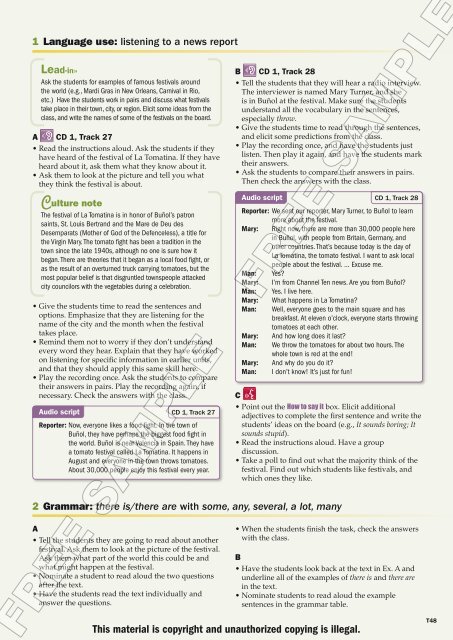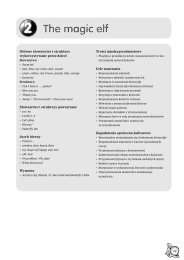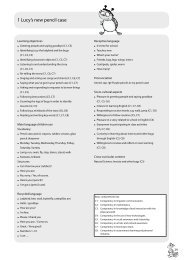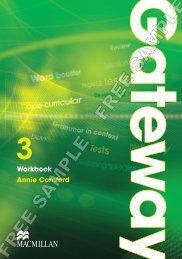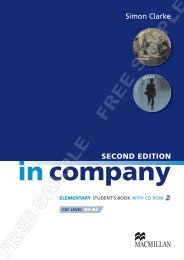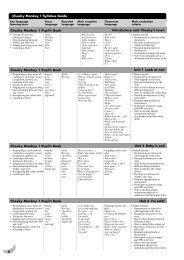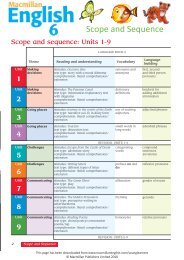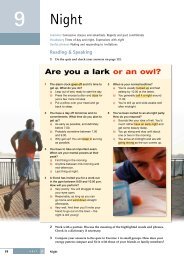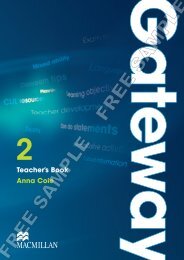there are - Macmillan
there are - Macmillan
there are - Macmillan
You also want an ePaper? Increase the reach of your titles
YUMPU automatically turns print PDFs into web optimized ePapers that Google loves.
1 Language use: listening to a news reportLead-in»Ask the students for examples of famous festivals aroundthe world (e.g., Mardi Gras in New Orleans, Carnival in Rio,etc.) Have the students work in pairs and discuss what festivalstake place in their town, city, or region. Elicit some ideas from theclass, and write the names of some of the festivals on the board.A CD 1, Track 27• Read the instructions aloud. Ask the students if theyhave heard of the festival of La Tomatina. If they haveheard about it, ask them what they know about it.• Ask them to look at the picture and tell you whatthey think the festival is about.Culture noteThe festival of La Tomatina is in honor of Buñol’s patronsaints, St. Louis Bertrand and the M<strong>are</strong> de Deu desDesemparats (Mother of God of the Defenceless), a title forthe Virgin Mary. The tomato fight has been a tradition in thetown since the late 1940s, although no one is sure how itbegan. There <strong>are</strong> theories that it began as a local food fight, oras the result of an overturned truck carrying tomatoes, but themost popular belief is that disgruntled townspeople attackedcity councilors with the vegetables during a celebration.• Give the students time to read the sentences andoptions. Emphasize that they <strong>are</strong> listening for thename of the city and the month when the festivaltakes place.• Remind them not to worry if they don’t understandevery word they hear. Explain that they have workedon listening for specific information in earlier units,and that they should apply this same skill here.• Play the recording once. Ask the students to comp<strong>are</strong>their answers in pairs. Play the recording again, ifnecessary. Check the answers with the class.Audio scriptCD 1, Track 27Reporter: Now, everyone likes a food fight. In the town ofBuñol, they have perhaps the biggest food fight inthe world. Buñol is near Valencia in Spain. They havea tomato festival called La Tomatina. It happens inAugust and everyone in the town throws tomatoes.About 30,000 people enjoy this festival every year.A• Tell the students they <strong>are</strong> going to read about anotherfestival. Ask them to look at the picture of the festival.Ask them what part of the world this could be andwhat might happen at the festival.• Nominate a student to read aloud the two questionsafter the text.• Have the students read the text individually andanswer the questions.B CD 1, Track 28• Tell the students that they will hear a radio interview.The interviewer is named Mary Turner, and sheis in Buñol at the festival. Make sure the studentsunderstand all the vocabulary in the sentences,especially throw.• Give the students time to read through the sentences,and elicit some predictions from the class.• Play the recording once, and have the students justlisten. Then play it again, and have the students marktheir answers.• Ask the students to comp<strong>are</strong> their answers in pairs.Then check the answers with the class.Audio scriptCD 1, Track 28Reporter: We sent our reporter, Mary Turner, to Buñol to learnmore about the festival.Mary: Right now, <strong>there</strong> <strong>are</strong> more than 30,000 people herein Buñol, with people from Britain, Germany, andother countries. That’s because today is the day ofLa Tomatina, the tomato festival. I want to ask localpeople about the festival. … Excuse me.Man: Yes?Mary: I’m from Channel Ten news. Are you from Buñol?Man: Yes. I live here.Mary: What happens in La Tomatina?Man: Well, everyone goes to the main squ<strong>are</strong> and hasbreakfast. At eleven o’clock, everyone starts throwingtomatoes at each other.Mary: And how long does it last?Man: We throw the tomatoes for about two hours. Thewhole town is red at the end!Mary: And why do you do it?Man: I don’t know! It’s just for fun!C• Point out the How to say it box. Elicit additionaladjectives to complete the first sentence and write thestudents’ ideas on the board (e.g., It sounds boring; Itsounds stupid).• Read the instructions aloud. Have a groupdiscussion.• Take a poll to find out what the majority think of thefestival. Find out which students like festivals, andwhich ones they like.2 Grammar: <strong>there</strong> is/<strong>there</strong> <strong>are</strong> with some, any, several, a lot, many• When the students finish the task, check the answerswith the class.B• Have the students look back at the text in Ex. A andunderline all of the examples of <strong>there</strong> is and <strong>there</strong> <strong>are</strong>in the text.• Nominate students to read aloud the examplesentences in the grammar table.FREE SAMPLE FREE SAMPLEThis material is copyright and unauthorized copying is illegal.T48


